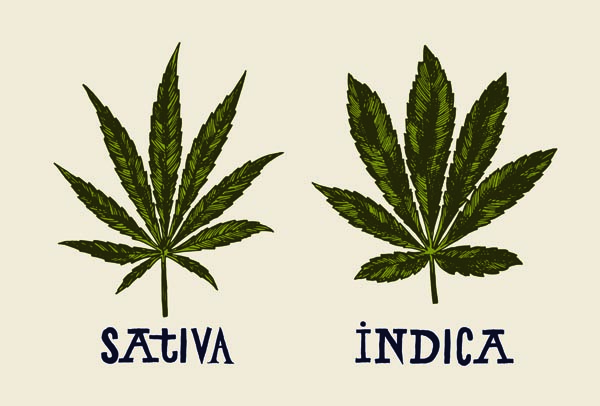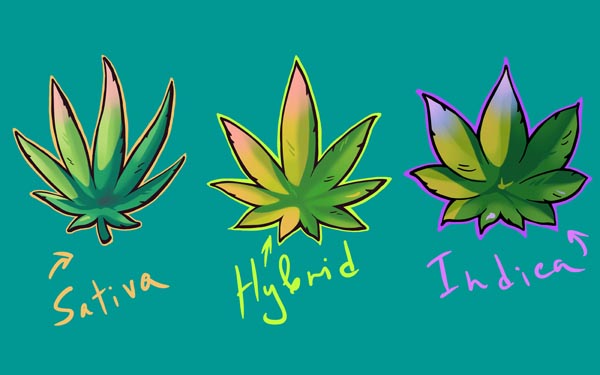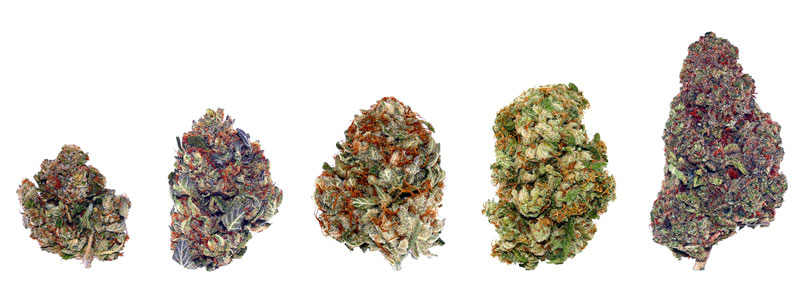Indica vs Sativa
The difference between an Indica and a Sativa is like the difference between a Bulldog and a Poodle. They serve completely different “work” purposes, yet they are the same species and are similar in many ways.

Cannabis Indica and Cannabis Sativa are the two mainstream varieties of cannabis that we consume today and they have bold differences in appearance, application and medical benefits.
There are also two other varieties of cannabis, Cannabis Ruderalis and Cannabis Afghanica. These varieties are not mainstream like Indica and Sativas are, although, their unique genetics have helped create many of the modern cannabis strains we have today through breeding programs and also by chance.
To learn more about the varieties of cannabis, we invite you to read our “What is Cannabis?” article.
In this article, we will focus on the differences between the Indica and Sativa cannabis varieties.
We encourage you to ask questions or make comments below the article.
What are Indicas? And What are Sativas?
There are many differences between Indicas and Sativas. Once you understand these differences it will make the task of identifying a strain much easier.
The chart below illustrates the contrasting characteristics of Cannabis Sativa and Cannabis Indica:
Sativa |
Indica |
|
Large, long, thin, light colored leaves |
Short, wide, dark colored leaves |
|
Tall plants (8 - 15 feet in height) |
Short Broad plants (2 to 6 feet in height) |
|
Grows tall, with greater length between internodes, a large extensive root system, large and narrow leaves, and flowers that grow further apart. |
Grows short and bushy, with a condensed root system, stout stems with broad leaves, and dense compact flowers. |
|
Traditionally High THC Level |
Traditionally Medium THC Level |
|
Traditionally Lower CBD:THC Ratio |
Traditionally Higher CBD:THC Ratio |
|
Produces feelings of euphoria, alertness and energized cerebral effects. |
Produces a “Body High” as well as relaxed and sedated effects. |
|
Best for daytime use or when you need to be focused, awake and alert. |
Best for nighttime use or when you want to relax and rest. |
|
For the Mind. |
For the Body. |
|
Typically best suited for depression, ADHD, other mood disorders and fatigue. |
Typically best suited for insomnia, body pain and other physical ailments. |
|
Originated in Asia, the Americas and Africa, with each region having specific characteristics. |
Originated in the mountainous regions of India and Pakistan. |
|
Pure sativa strains flower several weeks or months later than pure indica strains. They take longer to grow to maturity than Indicas. |
Shorter flowering time than Sativas by several weeks or months. They take less time to grow to maturity than sativa strains. |
|
Sativa flowers are long, thin and airy like the plants |
Indica flowers are short, broad and dense like the plants |
Please note, these are general guidelines and are not always accurate. For example, there are modern Sativas strains that will have low THC and very high CBD, while there will be modern Indica strains that have High THC and low CBD.
From a medical benefits standpoint, many experts agree that Indicas are for the body while Sativas are for the mind.
What is an Example of an Indica Strain?
 A great example of a 100% Indica strain is Hindu Kush. It originated from the mountainous region between Pakistan and Afghanistan and has been a popular strain for centuries due to its potent euphoric, relaxing and sedative effects.
A great example of a 100% Indica strain is Hindu Kush. It originated from the mountainous region between Pakistan and Afghanistan and has been a popular strain for centuries due to its potent euphoric, relaxing and sedative effects.
Hindu Kush has been used to help combat health ailments like insomnia, pain, muscle spasms, migraines, anxiety, depression, nausea and loss of appetite. It is best suited for the evening hours before bed since it causes drowsiness and promotes sleep.
This is not a strain to use during the daytime unless you want to relax and rest during the day.
This is a landrace strain that has been used to develop many modern strains. For example, the legendary OG Kush and Pink Kush are descendants of the Hindu Kush strain.
What is an Example of a Sativa Strain?
A great example of a 100% Sativa strain is Durban Poison. It originated from what is now the Durban area of South Africa and is known as an “ancient” strain that has been part of the landscape as long as people can remember. Durban Poison is a popular sativa strain due to the potent euphoric, energetic and focusing effects that it produces for users.
Durban Poison has been used to help combat health ailments like fatigue, migraines, ADD/ADHD, type 2 diabetes and depression. It is best suited for the morning or the afternoon because of its intense energetic effects.
This is not a night time strain unless you want to stay up and be productive.
It is a 100% landrace Sativa strain that has been a strain of choice for hundreds, if not thousands of years.
How Many Different Strains Exist?
Today, hundreds of strains “exist.”
Some of these strains are Indicas and some of these strains are Sativas, while a combination of both are called Hybrids. Hybrid strains have a genetic makeup that has both sativa and Indica genetics, therefore they share characteristics of both varieties. Some hybrids are Indica Dominant, while others are Sativa Dominant. 50/50 Hybrids share the genetics of their parent strains equally; half are Indica and half are Sativa.
Hybrids are becoming very popular around the world because they can provide benefits from both the Indica and Sativa cannabis varieties.
There are Typically 5 Strain Varieties that the Cannabis Community uses to Identify Strains

The five categories are as follows:
- Indica
- Sativa
- Hybrid - 50/50
- Hybrid - Indica Dominant
- Hybrid - Sativa Dominant
To learn more about these cannabis varieties and their characteristics, we invite you to explore the following Kanteeva resources and articles:
- Our Strain Directory
- Defining a Strain - A Guide to the Kanteeva Strain Directory
- What is a Strain?
- What is Cannabis?
Have you had the opportunity to try different cannabis strains? Please let us know what your experience has been like with Sativa and Indica strains by commenting below and be sure to join the Kanteeva community to discover some other great strains that the community is finding success with.
Learn. Share. Connect.